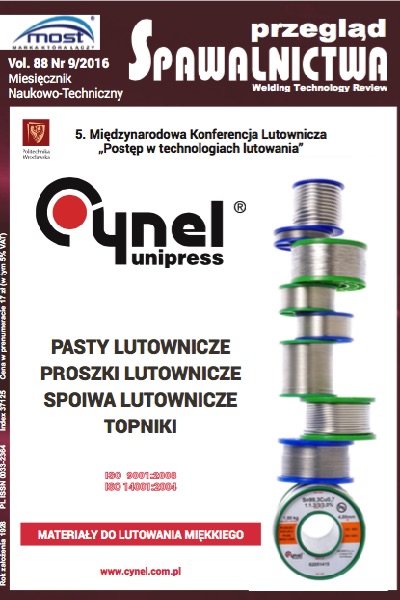Calculation of Thermodynamically Optimized Temperature-/Time-Cycles in Nickel-Based Brazing Joints
Main Article Content
Abstract
Brazing with nickel-based filler materials is an established joining process. In this context the formation of brittle phases in the joint is a significant difficulty. An increased proportion of these phases influences the mechanical properties of the joints negatively. This effect gains strong influence if a continuous band of brittle phases is formed. In order to avoid formation of brittle phases, small brazing gaps are necessary. Subsequent heat treatment is partially able to reduce the proportion of brittle phases. In this paper thermodynamic simulations are applied in order to calculate phase transformations and diffusion processes during brazing of commonly used materials. The simulations are performed by using Thermo-Calc and TC Dictra, as well as an analytical model. Different temperature-/time-cycles are examined in order to characterize their influence on the formation of brittle phases. Additionally, experiments were executed with the materials of interest. Nanoindentation is used to determine local values of YOUNGs modulus and indentation hardness. Miniature tensile tests are applied to examine the tensile strength. The evaluated data is used to specify correlations between the properties of brittle phases in the joint and of its global mechanical properties.
Optymalizacja temperatury/cykli czasowych w lutowaniu twardym poprzez obliczenia termodynamiczne
Streszczenie
Lutowanie materiałów z wykorzystaniem lutów na osnowie niklu jest już procesem znanym i opanowanym. W tym kontekście tworzenie się w złączu kruchych faz jest istotnym problemem. Wzrastająca ilość tych faz wpływa negatywnie na własności mechaniczne połączenia. Efekt ten zwiększa się jeżeli lut produkuje się w postaci taśmy i ilość kruchych faz jest wyraźnie większa. Uniknięcie formowania się kruchych faz zmusza do stosowania małych szczelin lutowniczych. Stosowana dodatkowo obróbka cieplna również częściowo redukuje ilość kruchych faz. W przedstawianej pracy zastosowano symulację termodynamiczną w celu określenia przemian fazowych i procesu dyfuzji w złączu lutowanym. Symulacje wykonano przy pomocy Thermo-Calc i TC Dictra oraz modelu analitycznego. Sprawdzano różne cykle temperatura/czas aby ustalić ich wpływ na tworzenie kruchych faz. Wykonano dodatkowo wybrane badania dotyczące interesujących nas materiałów. Zastosowano metodę pomiaru nanowgłębienia do określenia lokalnego modułu Younga oraz pomiaru twardości. Badanie wytrzymałości na rozciąganie wykonano na próbkach miniaturowych. Wyniki pozwoliły ustalić wpływ ilości kruchych faz w złączu na własności mechaniczne całego połączenia.
Downloads
Article Details
Creative Commons CC BY 4.0 https://creativecommons.org/licenses/by/4.0/
Welding Technology Review (WTR) articles are published open access under a CC BY licence (Creative Commons Attribution 4.0 International licence). The CC BY licence is the most open licence available and considered the industry 'gold standard' for open access; it is also preferred by many funders. This licence allows readers to copy and redistribute the material in any medium or format, and to alter, transform, or build upon the material, including for commercial use, providing the original author is credited.
References
H.-D. Steffens, B. Wielage: Verhalten von Hochtemperaturlötverbindun- gen bei schwingender Belastung und erhöhten Temperaturen. Z. Werk- stofftechnik 8, pp. 8288 (1977).
E. Lugscheider, O. Knotek, K. Klöhn: Melting behaviour of Nickel-Chromium-Silicon Alloys, Thermochimica 29, pp. 323326 (1979).
K.-D. Partz: Einfluss von Lötparametern auf die Zugfestigkeit stumpfgelöteter Hochtemperaturlötverbindungen Parametercharakteristik der Lötsysteme BNi-2, BNi-5, BNi7/1.4961, 1.4550. RWTH Aachen, Dissertati- on (1981).
H. Krappitz: Duktilitätsverhalten hochtemperaturgelöteter Verbindungen warmfester Werkstoffe. RWTH Aachen, Dissertation (1986).
G.M. van Gulik, P. Heilmann: Hochtemperatur-Vakuumlöten mit anschließender Vakuum-Wärmebehandlung eine rationelle technische Lösung. In: Hart- und Hochtemperaturlöten und Diffusionsschweißen, DVS-Berichte 125, pp. 69 (1989).
W. Müller: Metallische Lotwerkstoffe. Deutscher Verlag für Grundstoffindustrie (1990).
B. Wielage, L. Martinez: Hochtemperaturlöten von hochlegierten Stählen mit modifizierten Standardloten, Hart- und Hochtemperaturlöten und Dif- fusionsschweißen, DVS-Berichte 212 pp. 346349, (2001).
W.C. Oliver, G.M. Pharr, An improved technique for determining hardness and elastic modulus using load and displacement sensing indentation experiments. J. Mater. Res. Vol. 7 No 6, pp. 15641583 (1992).
